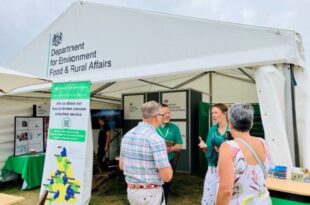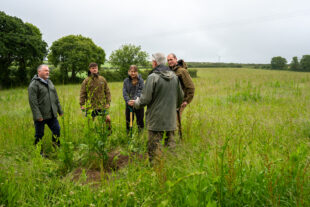On Friday 26 January, we held a webinar for farmers. We went through the actions and payments available through our environmental land management schemes in 2024.
This webinar was held in collaboration with the Farming Advice Service (FAS) and The Farming Forum (TFF). In addition to the recording, FAS have shared a podcast of the webinar.
Defra’s Farming and Countryside Programme Director, Janet Hughes was joined by the Sustainable Farming Incentive policy lead, Jonathan Marsden, and colleagues from the Rural Payments Agency (RPA).
We want to make sure that these webinars are designed and delivered in a way that presents the information clearly and in an engaging way, so we encourage feedback.
After this particular webinar, you told us you wanted more webinars like this. We sent out surveys before and after and the overwhelming majority of attendees said they had a greater understanding of the Sustainable Farming Incentive offer and felt confident recommending the scheme to others. So, we’ll keep going!
In this post, I’ll summarise the themes and top-voted questions covered in the webinar with responses and links to guidance.
If you’ve read the guidance and still have questions, I’ll set out the best ways for you to get answers as quickly as possible at the end of this post.
The Sustainable Farming Incentive (SFI), Countryside Stewardship (CS) and the combined offer
We’re streamlining the way we present our offer. We currently have separate SFI and CS Mid and Higher Tier schemes offering different types of actions and agreements.
We plan to offer most SFI and CS Mid Tier actions through a single application service in 2024, rather than having separate application windows and processes.
We’ll also remove duplication between SFI and CS Mid Tier actions, wherever possible.
CS Higher Tier agreements are different on each farm, and are more complex requiring advice, support and in many cases formal consent. We will continue to operate a separate process for these agreements, but we will offer the agreements through a simpler, clearer and faster service.
We will make more actions currently only available in CS Higher Tier available through our other offers. This will mean that, where appropriate, more farmers can access those more ambitious elements with the necessary advice and support for those actions.
Learn more about the combined offer.
After 2025, we’ll incorporate other schemes through that single service too, including the England Woodland Creation Offer.
Opening up SFI to non-BPS farmers
This summer, we plan to remove the current rule saying that farmers must be eligible for BPS to apply for SFI. We’ll let you know when this happens, so make sure to subscribe to the Farming blog.
When to apply for an SFI agreement
Don’t delay, apply today!
You can apply for an SFI agreement now and choose from the 23 actions currently on offer. By waiting for the 2024 actions to become available, you could be losing out on money. If you apply now, you'll be able to add actions to your agreement annually - or have multiple agreements if you'd like to carry out further actions in the future.
It’s possible to be in SFI and Countryside Stewardship at the same time if the actions are compatible and you are not being paid for the same action twice (see the section below on the combined offer).
Find out how SFI can work for you.
Agreement lengths
Your SFI agreement will last for 3 years from its start date.
SFI agreements do not all start on a single date. They start on the first day of each calendar month.
Your SFI agreement’s start date will depend on:
- when you submit your SFI application
- how long it takes to process so we can offer you an SFI agreement
- how quickly you accept your SFI agreement offer
The start date for your SFI agreement will be shown on your agreement document.
The official guidance for how your SFI agreement works is on GOV.UK.
Keeping record of your activities
You need to be able to evidence that you have achieved the actions aims. For example, for winter bird food (AHL2) we’ll need to see some spring and summer flowering.
Taking photos and short videos is useful as these can clearly demonstrate meeting the action’s aim.
Read the full guidance on how to take photos as evidence
The species-rich grassland actions and priority habitat mapping
We acknowledge that the priority habitat’s data layer isn’t perfect and a lot of grassland habitats out there that aren't on the layer.
If you feel your field or your parcel of land isn't on the map, but you feel it is species-rich grassland, then we’ll introduce a facility for an adviser to come out and support your application.
Read the full guidance for grassland actions
Defining wood pasture and agroforestry
Wood pasture and parkland is a priority habitat defined by several features which include a variety of open areas, scrub and trees. Wood pasture is a whole-system option with specific requirements for land management.
Agroforestry is simply the integration of trees into farmed land, without additional requirements. Agroforestry is a stackable option without specific requirements for land management.
Read the full guidance for wood-pasture actions
Payment rates for agroforestry
| Theme | Action | 2024 payment rate with premium (per ha) |
| Agroforestry | Maintain very low density in-field agroforestry on more sensitive land | £248 |
| Agroforestry | Maintain low density in-field agroforestry on less sensitive land | £385 |
| Agroforestry | Maintain low density in-field agroforestry on more sensitive land | £385 |
| Agroforestry | Maintain medium density in-field agroforestry | £595 |
| Agroforestry | Maintain high density in-field agroforestry | £849 |
Further guidance on density will be published before applications open.
Payment rates for agroforestry
Environment Agency approval for water body measures
Water body measures require a permit from the Environment Agency where actions physically alter a main river, require a supply of water or have the potential to affect flooding and flood defences.
On ordinary watercourses or in Internal Drainage Districts water body measures may require consent from the Lead Local Flood Authority or Internal Drainage Board.
Read the full guidance on waterbodies
Dartmoor Hill ponies and the cattle grazing and native breed grazing options
Dartmoor Hill ponies do fall under these options. There are additional payments where cattle and ponies graze moorland as an alternative to sheep. In addition where grazing animals are listed as Rare and Native there will be supplements available. This Rare and Native breed lists includes Sheep, Cattle, ponies.
Read the full guidance on moorland actions
Accessing orchard creation options
Traditional orchard eligibility will expand to allow creation on:
- sites with evidence (such as maps or photographs) that a traditional orchard were once locally present - this includes sites currently under arable cultivation
- sites where creation generates valuable trees outside woodland. For example: extends, links or buffers existing tree features such as landscapes with open grown trees, hedgerow trees, agroforestry, wood pasture and parkland (WP&P) or priority woodland habitats.
This makes traditional orchard creation accessible where it extends the existing treescape, but it is not available to all.
Read the full guidance on orchards
Further support and guidance
With improved choice and payment rates, now is the time to apply for SFI.
For more information, visit our dedicated SFI site which sets out the full offer. The RPA created a video on how to apply for SFI.
To help you manage the transition and plan, can access free advice through an independent provider if you receive BPS.
Catchment Sensitive Farming (CSF) helps farmers in England protect water, air and soil. CSF advisers can provide advice on best practices and specific SFI actions that will benefit your farm business and the environment.
If you have a query about your SFI application, you can contact the RPA.
In this post, I’ve just covered our environmental land management schemes.
The guidance for every scheme and grant on offer can be found on the Funding for farmers, growers and land managers page on GOV.UK.





8 comments
Comment by Margaret Peake posted on
As well as farmers, it would be useful if it were easier to find grants that are available on Common Land. We have joined the SFI but most of the information given is for farmers' own land and not for Commons, which are potentially a rich source of bio-diversity and carbon storage.
Comment by The Team posted on
Hi Margaret,
Thank you for getting in touch. SFI is available on common land, together with an additional payment for commons that is intended to reflect the additional costs of setting up and managing the required single entity and agreements between commoners. Full details given here:https://www.gov.uk/guidance/eligibility-of-commons-and-shared-grazing-land-for-an-sfi-agreement
Hope that helps,
The Team
Comment by Colin Charnock posted on
I’m a tenant farmer with an area of recently designated sssi raised peat bog I’m barred from entering SFI by natural England unless I bankroll the restoration on land I don’t own I spoke to Janet Hughes about this on 2 separate occasions on Zoom meetings a while a go and she assured me she would be in touch, that will be over 12 months ago.
Comment by The Team posted on
Hi Colin,
Thank you for your query. We cannot comment on the individual detail of your case, but can provide information that may be helpful to your situation; as a tenant you are eligible for SFI if you expect to have management control of the land entered into your SFI agreement for its 3-year duration, more information on eligibility is listed here: https://www.gov.uk/guidance/what-land-is-eligible-for-an-sfi-agreement#how-we-define-eligible-land-types-and-features-for-sfi. Where land is designated as SSSI you may need consent for some actions under SFI, please see details https://www.gov.uk/guidance/regulatory-issues-and-consents-that-could-affect-you-and-the-land-in-an-sfi-agreement.
In terms of restoration of raised peat bog; we announced in January as part of improvements to the Environmental Land Management Schemes https://defrafarming.blog.gov.uk/2024/01/04/environmental-land-management-in-2024-details-of-actions-and-payments/, that we are increasing the payment rate for re-wetting moorland peat in Countryside Stewardship from £25 to £181 per hectare. This payment rate will be available alongside payments for capital to fund restoration of upland peat. This activity is likely to need landlord consent.
We will be publishing more detail later this year on the updated offer for 2024.
Hope that helps,
The Team
Comment by Julie Wickington posted on
Hi Team,
Please can you clarify the process if you already have a Mid-Tier CS agreement?
Specifically:
Can you apply for new CS options e.g. Creating Species Rich Grassland on land that is already in a CS agreement?
If not, what is the process for CS Mid-Tier agreement holders? Can you come out of your CS existing agreements and apply for a new combined offer, that offers greater environmental benefits?
Many thanks Julie
Comment by The Team posted on
Hi Julie,
If land is in a CS agreement, you can enter the same area of eligible land into an SFI agreement. The requirements are explained here: https://www.gov.uk/guidance/eligibility-of-land-for-an-sfi-agreement-thats-used-for-other-schemes-and-funding-sources#land-schemes
Essentially, your SFI agreement and CS agreement can sit alongside each other on the same bit of land, we just won't twice for a similar activity or outcome on the same area of land at the same time.
We currently have separate SFI and CS Mid and Higher Tier schemes which offer different types of actions and agreements. We plan to offer most SFI and CS Mid Tier actions through a single application service this year rather than having separate application windows and processes. We also plan to remove duplication between SFI and CS Mid Tier actions wherever possible. We'll share updates on the blog.
If you're BPS eligible, you can get free, independent advice from a provider in your area - the list of providers is here: https://www.gov.uk/government/publications/get-free-business-advice-for-your-farm/organisations-giving-free-advice-in-your-area-listed-by-county
Or, you can get in touch with the RPA: https://www.gov.uk/government/publications/contact-the-rpa-about-sfi
Best wishes,
The Team
Comment by Lucy posted on
With regards to the Species rich grassland option on land that isn't mapped on the PHI, at what stage will the 'facility' (presumably NE adviser) be available?
Is it best just to go ahead and apply? Will you require records such as photos of past season's growth together with a location? If you apply for a Combined offer in say November, it is likely that there won't be any species on show for the adviser to survey. Will this create a delay in an application?
What records would be useful to prepare this Spring and Summer?
Comment by The Team posted on
Hi Lucy,
We'll share more information about this as soon as we can. In the meantime, photos of the sward composition (taken in May/June/July) are likely to be very helpful. For creation, a soil phosphate index of below 2 is also likely to be helpful too.
Best wishes,
The Team